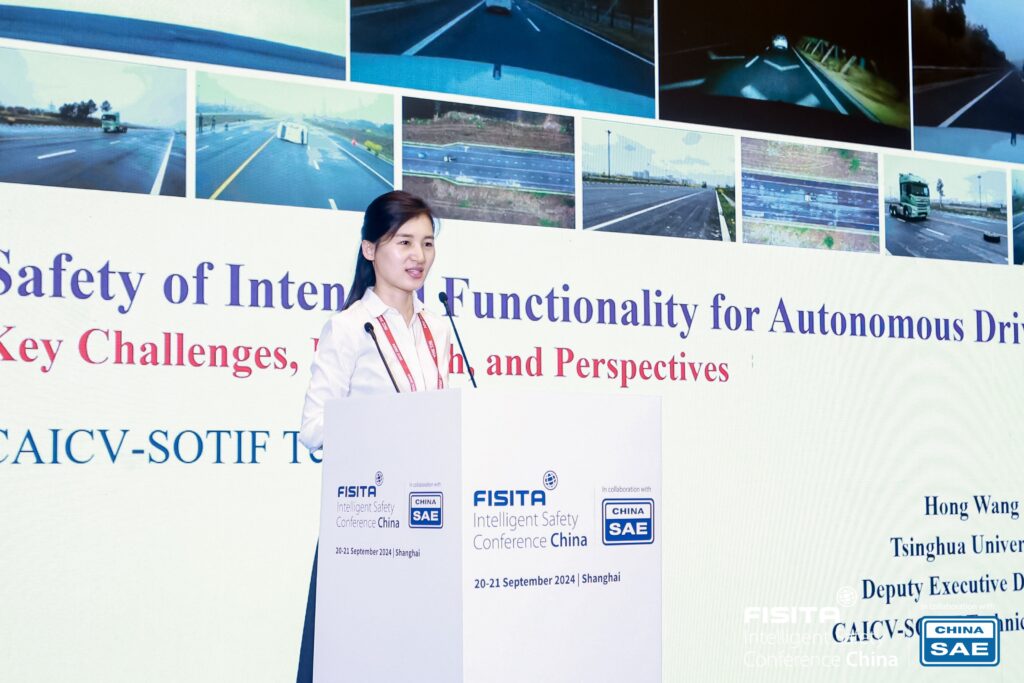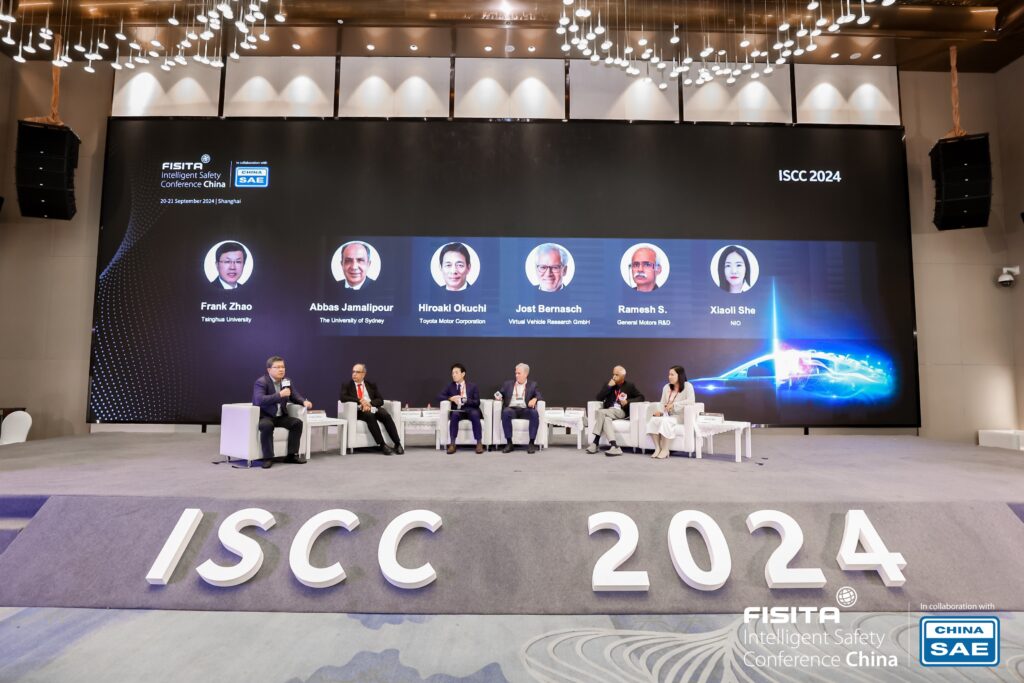The sixth annual FISITA Intelligent Safety Conference China (ISCC) took place in September 2024 in Shanghai. Martin Kahl, CTO of FISITA, reflects on the event’s highlights
Despite impressive advances in automotive technology, rapidly evolving business models, increasingly stringent emissions regulations, and ever-changing consumer preferences and expectations, one topic remains constant—and global: safety. The 2024 edition of Intelligent Safety Conference China took place in September in Shanghai, with a focus on safety testing and evaluation, collaborative driving, cyber security, and the role of artificial intelligence (AI) in autonomous driving safety.
The transition to electrification, the shift from driver experience to user experience, and increasing levels of automation all bring new challenges to automakers, suppliers, and indeed consumers. In early 2024, the new China New Car Assessment Program (C-NCAP) protocol was published to reflect these changes, updating China’s vehicle safety assessment program with a focus on vehicle occupant protection, vulnerable road user (VRU) protection, and active safety, emphasising the role of advanced driver assistance systems (ADAS), driver monitoring systems (DMS), and road feature recognition.
Against this backdrop, the sixth annual FISITA Intelligent Safety Conference China took both a big picture look at advances in automotive safety, and a deep dive into specific safety topics. Thanks to a hybrid element that broadened the event’s reach and enabled virtual presentations and attendance, the event featured presentations, panel discussions and technical sessions delivered by engineers and technical leaders drawn from a rich mix of industry and academia.
the sixth annual FISITA Intelligent Safety Conference China (ISCC) took place in September in Shanghai

Lily Lu, Deputy Secretary-General of China SAE welcomed more than 300 attendees to the event, which opened with keynotes from Fushen Hou, Executive Vice President and Secretary General of China SAE, FISITA Chief Executive Chris Mason, and Xiaohong Pan, General Manager of Shanghai International Automobile City.
FISITA’s Chris Mason provided an overview of safety and automated driving from a European perspective, underlining the impact of the European Union’s updated General Safety Regulation, known more commonly as GSR II, under which all new vehicles sold in the EU must now be equipped with various new safety and ADAS features such as Intelligent speed assistance (ISA), advanced emergency braking systems (AEBS), and driver monitoring systems (DMS). “A key aspect of GSR II is that it also established the first legal framework to allow automated and fully driverless cars to become available on European roads,” he noted.
Fushen Hou’s keynote focused on three trends in automotive safety in China: the country’s accelerated adoption of AI, the speed at which autonomous driving is being developed in China, and the rapid emergence of solutions that integrate vehicle, road, and cloud. And Xiaohong Pan used her keynote to illustrate the key role played by Shanghai International Automobile City in two decades of vehicle and road safety solution development; indeed, both speakers emphasised the need now more than ever for cooperation and collaboration to ensure the safe incorporation of intelligent and connected vehicle technology.
Automated driving was the focus of keynotes from Jun Li, Honorary President, China SAE, who discussed the critical importance of solving system safety issues before launch, and operational safety issues after launching autonomous driving systems; and Jost Bernasch, CEO of Virtual Vehicle Research, who addressed the topic of type approval for automated driving, and the use of virtual assessment to increase effectiveness.
"A key aspect of GSR II is that it also established the first legal framework to allow automated and fully driverless cars to become available on European roads" – Chris Mason, CEO FISITA

Several automakers shared insight, with keynote talks from SAIC Motor, General Motors, Toyota, and FAW. Sijie Zu, Vice President & Chief Engineer at SAIC Motor, discussed ways to accelerate the development of intelligent cars, and Ramesh S., Technical Fellow at General Motors, spoke on emerging safety guidelines and standards for AI-based automotive systems. Hiroaki Okuchi, Fellow, Toyota Motor Corporation, presented key aspects of the company’s safety initiatives including the suite of ADAS and active safety systems known as Toyota Safety Sense, and Xuezhu Yang, China FAW Group’s Senior Director of System Safety, shared the latest developments in FAW’s safety strategy.

Several discussions took place around the topic of SOTIF. Dr Hong Wang, Associate Research Professor at Tsinghua University and a member of the FISITA Intelligent Safety Expert Group, provided a comprehensive analysis of trends in the evolution of SOTIF for intelligent and connected vehicles, and Mark Vernacchia, Principal and Co-Founder of SSE Group gave a talk on SOTIF and system-theoretic process analysis (STPA).
Delegates also heard presentations on the potential of next-generation telecommunications protocols in automotive safety and advanced transportation systems, the development of human-machine interaction, and the role of global standards for realising next-generation vehicle technology.

Appropriately, AI and automated driving were the subjects chosen for two panel discussions. Jummin Wang, Professor at the University of Texas, moderated a panel on AI algorithms in autonomous driving, with a panel that featured Kyoungseok Han, Associate Professor at Kyungpook National University; Melkior Ornik, Assistant Professor at University of Illinois Urbana-Champaign; Michael Paulweber, Director Global ITS Research & Technology at AVL List GmbH; and Chongfeng Wei, Associate Professor at University of Glasgow.
The name Intelligent Safety Conference China may imply an exclusive focus on one country, but with half of the speakers from outside China, operating on a worldwide challenge in a worldwide industry, this event highlighted the global need to improve road safety worldwide, and protect vehicle occupants and all road users

The panel on autonomous driving was moderated by Frank Zhao, FISITA Honourable Lifetime President, Director of Tsinghua Automotive Strategy Research Institute and Professor at Tsinghua University. The topic, “Navigating the future of autonomous driving: emerging trends and safety challenges,” was debated by Abbas Jamalipour, Professor at the University of Sydney, Fellow of the Australian Academy of Engineering; Hiroaki Okuchi of Toyota Motor Corporation; Jost Bernasch of Virtual Vehicle Research; Sijie Zu of SAIC Motor; Ramesh S. of GM; and Xiaoli She, Director of Quality and Safety, Intelligent Driving R&D Division at NIO.
The event also hosted the Global Young Scientists Forum, which addressed the role of AI in ensuring safe autonomous driving.
A global challenge
Information on road traffic fatalities in China varies according to source, with 62,218 fatalities reported in 2021, and World Health Organization (WHO) estimated road traffic fatalities for the same year standing at 248,099. Ignoring, for the purposes of this article, the rate of non-fatal incidents, the downward trend in both road traffic fatality statistics is a positive sign, particularly in a market with a growing population, and a growing new vehicle market and vehicle parc. Every life saved, and every fatal crash avoided, is in large part due to the work of safety experts such as the speakers and delegates at Intelligent Safety Conference China 2024. The event’s name may imply a focus on one country, but with half of the speakers from outside China, operating on a worldwide challenge in a worldwide industry, this event highlighted the global need to improve road safety worldwide, and protect vehicle occupants and all road users.